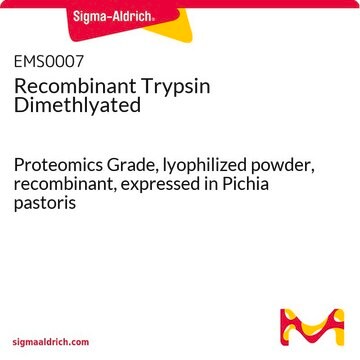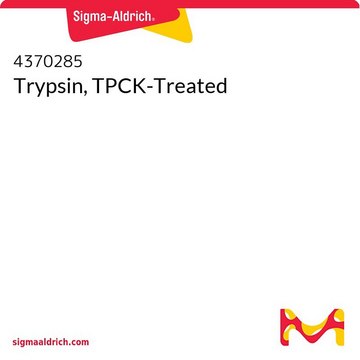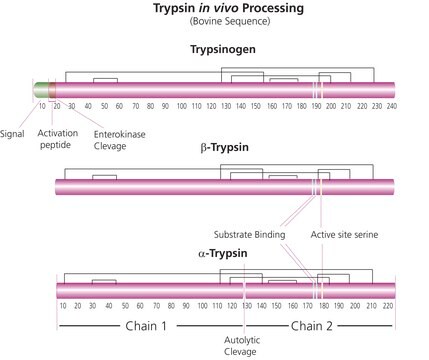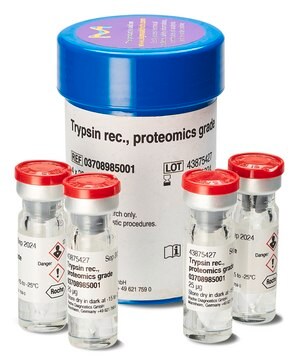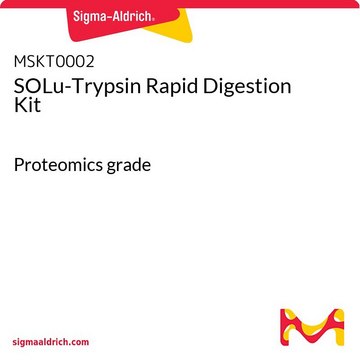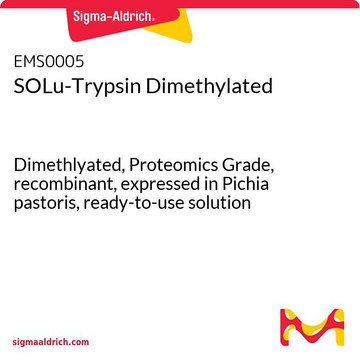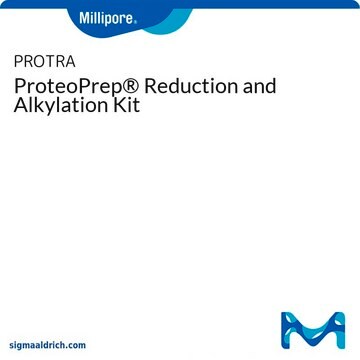Key Documents
T7575
Trypsin Singles, Proteomics Grade
Synonim(y):
Proteomics grade, Trypsin, TPCK treated
About This Item
Polecane produkty
klasa czystości
Proteomics Grade
Poziom jakości
Postać
ready-to-use solution
aktywność właściwa
≥10,000 BAEE units/mg protein
masa cząsteczkowa
average mol wt 23.29 kDa
optymalne pH
~8.0
temp. przechowywania
2-8°C
Opis ogólny
Trypsin Singles, Proteomics Grade exhibit excellent proteolytic efficiency, generating more tryptic peptides leading to greater sequence coverage of your peptide of interest. Mass spectra are significantly simplified due to the reduced number of interfering autolytic peaks and their ambiguous adducts. Proteomics Grade Trypsin has been extensively purified from porcine pancreas to enable accurate and precise cleavage on the carboxylic side of Arg and Lys residues. The enzyme has been exhaustively processed by reductive methylation to minimize autolysis and chymotryptic activity has been quenched by TPCK treatment. Further purification steps including affinity chromatography and drying from dilute acid produce a highly purified, high specific activity trypsin purposely suited for the demanding criteria of proteomics research, and designed to function in either solution or gel-based digests.
Zastosowanie
Cechy i korzyści
- Convenient, single-use 1 μg size
- Eliminates repetitive pipetting
- Reductively methylated to minimize autolytic activity
- TPCK treated to quench chymotryptic activity
- Extensively purified
produkt powiązany
Hasło ostrzegawcze
Danger
Zwroty wskazujące rodzaj zagrożenia
Zwroty wskazujące środki ostrożności
Klasyfikacja zagrożeń
Acute Tox. 4 Dermal - Acute Tox. 4 Inhalation - Acute Tox. 4 Oral - Eye Irrit. 2 - Flam. Liq. 2 - Resp. Sens. 1 - Skin Irrit. 2 - STOT SE 3
Organy docelowe
Respiratory system
Kod klasy składowania
3 - Flammable liquids
Certyfikaty analizy (CoA)
Poszukaj Certyfikaty analizy (CoA), wpisując numer partii/serii produktów. Numery serii i partii można znaleźć na etykiecie produktu po słowach „seria” lub „partia”.
Masz już ten produkt?
Dokumenty związane z niedawno zakupionymi produktami zostały zamieszczone w Bibliotece dokumentów.
Klienci oglądali również te produkty
Nasz zespół naukowców ma doświadczenie we wszystkich obszarach badań, w tym w naukach przyrodniczych, materiałoznawstwie, syntezie chemicznej, chromatografii, analityce i wielu innych dziedzinach.
Skontaktuj się z zespołem ds. pomocy technicznej


